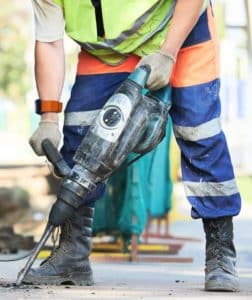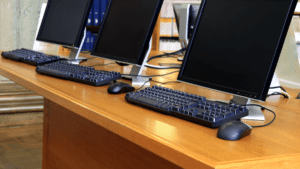Inventory management is an integral part of any fixed asset business. Choosing the right software solution for your inventory and asset management needs can be a tough task! There are a number of important factors, including cost, scalability, support, and integration with other software systems.
In this post we will look at three major fixed asset management software services: GoCodes Asset Tracking, Sage Fixed Assets, and Wasp. In doing so, we hope to simplify your search for the right service for your business!
In this article...
Solution Deployment
The deployment of asset management software can be placed into two broad categories: on-premise systems and cloud-based systems.
On-premise software is the more traditional type of software that comes on a CD/DVD and must be installed on a computer. It’s called “on-premise” because this type of system is installed and deployed from a computer (or a set of computers) that are physically located at your place of business. On-premise solutions offer some benefits, such as the ability to operate without an internet connection.
Cloud-based software is installed and deployed from a remote location (“the cloud”) and accessed through a web browser or a software-specific app, often called a “client” application. This type of software solution has gained popularity in the past decade and has become the norm for inventory and asset tracking deployment schemes. It offers a number of benefits over on-premise solutions, such as rapid scalability, flexibility, ongoing support and quick problem resolution.
For a more detailed explanation of the features, benefits, and drawbacks of cloud-based vs. on-premise solutions, check out this post.
Both of these general deployment schemes are viable and you should look to your general asset management strategy to find the right choice. Most growing small and medium-sized businesses will utilize a cloud-based solution because of its simplicity and scalability. Older businesses often come from a legacy inventory system that is deployed on-premise; since on-premise software must be periodically upgraded, such businesses must decide at each upgrade whether to continue with an on-premise solution or to migrate to a cloud solution.
Cloud-based solutions are hugely popular because of their flexibility and rapid deployment. There’s no need to install software and cloud user support makes the configuration process fast and painless. With GoCodes Asset Tracking, for example, a business can track inventory without computers or tablets; the mobile client provides all the features and access to the cloud-based software that are needed.
Sage and GoCodes Asset Tracking both offer cloud-based solutions. GoCodes Asset Tracking is an industry specialist in cloud-based asset tracking while Sage includes asset management as a part of their cloud-based enterprise resource planning (ERP) system or as a standalone product with Sage Fixed Assets. If you’ve decided to go with a cloud solution, Sage and GoCodes Asset Tracking are great options:
- GoCodes Asset Tracking’ product is more direct and pragmatic when inventory management is your key objective. It’s built to be simple, easy to use, quick to deploy, and extensible.
- Sage offers a number of intelligence and insight features that fit it with its ERP pipeline if inventory and asset tracking is just one piece of your resource planning strategy.
Wasp recently introduced a cloud-based version of its software, which is an option as well.
In the majority of cases, cloud-based is the way to go. There are, however, some unique situations that call for an on-premise alternative. One simple example is any business located in a remote area where internet connection is unreliable or nonexistent. (There are, however, ways for remote businesses to work around this issue.) Other businesses may have a longstanding policy of using on-premise software only, or may simply prefer to use it.
If you are looking for on-premise asset management software, Wasp offers by far the most extensive selection of on-premise packages. GoCodes Asset Tracking follows a cloud deployment model and does not offer on-premise options.
Hardware
In building an inventory management strategy, it’s important to consider what hardware you’re going to need to do the job.
Asset tracking is traditionally done with scanners, wireless receivers, and associated computer hardware. Good scanners are useful but can be pricey, are a liability and do not scale cheaply (a new scanner is needed for each new user).
If you decide to purchase scanners, Wasp has an extensive inventory of devices to get started. If you sign up for a Wasp inventory tracking package, it comes with a scanning hardware bundle as well, making the process simple. It also comes with a bit of sticker shock on the price of starting a plan with Wasp.
Sage Fixed Asset Tracking aims to be flexible. This means their product is compatible with a variety of scanning devices, but it’s up to the client to arrange for a scanning solution.
An innovative alternative to expensive scanning hardware is through the use of mobile devices and applications. GoCodes Asset Tracking has created a fast, deployable system that requires no new hardware beyond what you already have: the mobile device in your pocket. Mobile devices and tablets come with integrated cameras that can perform scanning tasks as reliably as dedicated scanning hardware. Arguably better than standalone scanners, mobile devices offer extended functionality with GPS tagging, mobile network connectivity, and simple convenience. Using a mobile application as a scanner gets around a few issues, such as expensive new hardware and complicated setup. With a mobile app, it’s as simple as downloading the app, signing in, and scanning.
GoCodes Asset Tracking’ mobile app is an elegant, low-cost solution that works well for growing businesses that need to be flexible and move quickly. The mobile app solution is by far the most flexible scanning option, because most employees have the necessary hardware with them. In a pinch, somebody can download the app on a personal device to solve a problem in minutes that may take hours or days with another system.
Cost
An excellent asset management system is well worth a significant investment. However, the amount you invest in your solution should be justified by its value to your business. That’s why it’s important to understand not only the differences in prices between providers and their products, but also the different features that your dollars pay for. This can help you pay for the features you need and avoid paying for features you will not use.
Wasp
Wasp’s software requires dedicated scanning hardware to operate, so it comes with an up-front price to purchase scanners and receivers; at its most basic service level, the starting price is $795. Wasp software comes with a month-to-month subscription as well. Depending on whether you use Wasp InventoryCloud (the cloud-based software), an on-premise package, the number of users, and other variables, this month-to-month cost will change and the pricing structure is a bit complicated. There is a useful pricing calculator available from their site to help with this.
GoCodes Asset Tracking
As a cloud-based service that does not sell scanning hardware, GoCodes Asset Tracking offers a simple month-to-month price on various levels of service. This price varies from $199/year for the standard plan to $199/month for their professional plan; the premium enterprise-level plan is priced to match the needs of your business. The benefit of this pricing scheme is it gives you a fixed cost of service and there are no high up-front costs. In fact, it’s free to start.
Sage Fixed Assets
Sage fixed asset tracking pricing is more opaque than the others. The product page does not offer pricing, but third-party price trackers suggest the price of their ERP services vary from $150 to $2,500 annually per user. Exact pricing depends on your business, so a direct quote is the only way to know your price with certainty.
Growing Costs
If significant growth in volume and scale is a part of your long-term business plan, you should consider the cost of scaling your asset management system. When looking at future growth, cloud solutions are the most appropriate as they scale seamlessly. GoCodes Asset Tracking, Sage, and Wasp all offer tiers of service that vary price with the number of users and/or the number of assets to track. Plan for the future and investigate pricing not only for where you are today, but for where you are going.
Asset management is an investment that will improve the logistics of your business, save time, and can prevent inventory loss. It’s a good idea to estimate the dollar value of these savings when budgeting for asset management software.
Migration
If you’re already tracking your inventory with a bar or QR code system, you need to consider the process of migrating from your current system.
Compatibility is a big piece of this. Make sure that your new system is compatible with the labels you already have on your assets. It’s best to speak with a representative before committing to a product to be sure.
GoCodes Asset Tracking is optimized for migration and makes the process simple. The system is compatible with QR codes and traditional bar codes, and it allows you to assign multiple labels to items. This makes migrating from a legacy system simple and avoids the need to replace bar codes. The migration assistance team can take your spreadsheet data and import it into their template to get things started quickly and seamlessly.
Sage Fixed Assets offers technical support for the use of their software, with tutorials and informational videos on getting started, through their informational website SageUniversity.
Wasp offers a lot of training resources on how to use their products, with information about installation, database configuration, and more available via on-demand education materials. Their products, especially on-premise software that requires installation and self-configuration, can take a bit of time and dedication of resources to migrate to. This is why the company provides so many training options for their clients.
Migration is a process not just for your business but for your entire team; they will appreciate the steps you take to make a smooth transition.
Product Support
Your inventory management solution is only as good as your ability to use it. When it comes to configuring your asset database, labeling your inventory, and integrating a solution into your workflow, it’s great to have a bit of help from the service providers. You should be able to rely on customer service and technical support teams for any problems that may arise in the future. Good product support should also include ongoing updates for data security.
With Wasp’s on-premise solutions, customer support is included in the purchase of software until the end of its life. The lifetime of a software product should be made clear at the time of purchase and depends on the version and terms of the purchased software license; it’s usually between 2-5 years but can be any amount of time.
During this lifetime, Wasp offers patches and upgrades. These are important as they will fix issues with the software as they arise, most importantly security vulnerabilities; with an on-premise installation, you’ll need to manually install these software patches.
Pay attention to the lifetime length of any product you’re looking to purchase as, at the end of its life, you’ll lose customer and technical support privileges as well as software security updates. The best thing to do at the end of a product’s life is to upgrade; budget for the cost of doing so.
A benefit of a cloud-based service and its ongoing subscription-based plan is the persistence of product support. This includes software upgrades, patches, and customer support. With Sage, GoCodes Asset Tracking, and Wasp’s cloud service product, you get the benefit of ongoing customer and product support with your subscription.
Getting Started
The best way to get to know a product is with hands-on experience. That’s why it’s a great idea to take advantage of free trials and demos when they are available. The drawback is that testing out a product takes time, so trying every product on the market may not be a viable option.
Wasp offers a free demo with no commitment. The demo process is not as fast, however, as some hardware is required to get up and running. After approving your request for a demo, Wasp will send trial scanners to let you try out their system. Upon receiving them, you’ll go through the process of setting up their hardware. This is a nice option but keep in mind the significant investment of time and resources getting the system up and running.
GoCodes Asset Tracking offers a free trial that is fast, painless, and commitment free; no credit card is required. Because of the simple, hardware-free cloud-based model, it’s simple and fast to set up a free GoCodes Asset Tracking trial run. You can download the app to a device, use existing bar codes or print new labels, and get your GoCodes Asset Tracking trial instance up and running in minutes.
Sage Fixed Assets does not appear to offer a free trial or demo at this time.
The Right Choice for Your Business
Take the time to weight your options and choose wisely. With so much variation in pricing, features, deployment, migration support, and product support, the process of narrowing down candidates can be daunting. As long as you clarify the needs of your business and your asset tracking plan, the service that best aligns with your goals should be easy to find.









